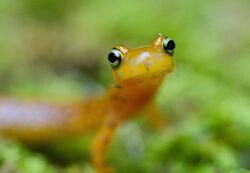Biology:Brook salamander
| Brook salamanders | |
|---|---|

| |
| Eurycea longicauda | |
| Scientific classification | |
| Domain: | Eukaryota |
| Kingdom: | Animalia |
| Phylum: | Chordata |
| Class: | Amphibia |
| Order: | Urodela |
| Family: | Plethodontidae |
| Subfamily: | Hemidactyliinae |
| Genus: | Eurycea Rafinesque, 1822 |
| Synonyms | |
| |
Brook salamanders are a genus, Eurycea, of salamanders native to North America.
Taxonomy
The genus Eurycea was first described by Constantine Samuel Rafinesque-Schmaltz in 1822, with a specimen of the spotted-tail salamander, Eurycea lucifuga, from Kentucky. The taxonomy of the genus is somewhat confusing, as many of the species within it are poorly studied and are found only in very restricted ranges, or deep within caverns. Several species have even been described several times by different researchers, and some are often considered to be morphologically different enough to warrant being placed into their own genera.
A recent taxonomic revision moved the Georgia blind salamander to this genus, which makes Haideotriton a synonym of Eurycea.[1]
Many sources also refer to several species of the genus as cave salamanders, due to their choice of habitat, or as blind salamanders, due to their reduced eyes, or the antiquated term for aquatic salamanders, Triton. Most species are from very isolated localities, so bear the name of the place the first specimen was found.
Species
This genus is composed of these 33 species:
| Binomial name and author | Common name |
|---|---|
| Eurycea aquatica Rose & Bush, 1963 |
Brown-backed salamander |
| Eurycea arenicola Stuart et al., 2020 |
Carolina Sandhills salamander |
| Eurycea bislineata (Green, 1818) |
Northern two-lined salamander |
| Eurycea braggi (Smith, 1968) |
Southern grotto salamander |
| Eurycea chamberlaini Harrison & Guttman, 2003 |
Chamberlain's dwarf salamander |
| Eurycea chisholmensis Chippindale, Price, Wiens & Hillis, 2000 |
Salado Springs salamander |
| Eurycea cirrigera (Green, 1831) |
Southern two-lined salamander |
| Eurycea guttolineata (Holbrook, 1838) |
Three-lined salamander |
| Eurycea hillisi Wray, Means, and Steppan, 2017 |
Hillis's dwarf salamander |
| Eurycea junaluska Sever, Dundee & Sullivan, 1976 |
Junaluska salamander |
| Eurycea latitans Smith & Potter, 1946 |
Cascade Caverns salamander |
| Eurycea longicauda (Green, 1818) |
Long-tailed salamander |
| Eurycea lucifuga Rafinesque, 1822 |
Spotted-tail salamander |
| Eurycea melanopleura (Cope, 1894 "1893") |
Dark-sided salamander |
| Eurycea multiplicata (Cope, 1869) |
Many-ribbed salamander |
| Eurycea nana Bishop, 1941 |
San Marcos salamander |
| Eurycea naufragia Chippindale, Price, Wiens & Hillis, 2000 |
Georgetown salamander |
| Eurycea neotenes Bishop & Wright, 1937 |
Texas salamander |
| Eurycea nerea (Bishop, 1944) |
Northern grotto salamander |
| Eurycea paludicola (Mittleman, 1947) |
Western dwarf salamander |
| Eurycea pterophila Burger, Smith & Potter, 1950 |
Fern bank salamander |
| Eurycea quadridigitata (Holbrook, 1842) |
Southeastern dwarf salamander |
| Eurycea rathbuni (Stejneger, 1896) |
Texas blind salamander |
| Eurycea robusta (Longley, 1978) |
Blanco blind salamander |
| Eurycea sosorum Chippindale, Price & Hillis, 1993 |
Barton Springs salamander |
| Eurycea spelaea (Stejneger, 1892) |
Western grotto salamander |
| Eurycea sphagnicola Wray, Means, and Steppan, 2017 |
Bog dwarf salamander |
| Eurycea subfluvicola (Steffen, Irwin, Blair, and Bonett, 2014) |
Ouachita streambed salamander |
| Eurycea tonkawae Chippindale, Price, Wiens & Hillis, 2000 |
Jollyville Plateau salamander |
| Eurycea troglodytes Baker, 1957 |
Valdina Farms salamander |
| Eurycea tynerensis Moore & Hughes, 1939 |
Oklahoma salamander |
| Eurycea wallacei (Carr, 1939) |
Georgia blind salamander |
| Eurycea waterlooensis Hillis, Chamberlain, Wilcox & Chippindale, 2001 |
Austin blind salamander |
| Eurycea wilderae Dunn, 1920 |
Blue Ridge two-lined salamander |
Diet
Eurycea eat a variety of small arthropods such as spiders, Armadillidiidae, and insects.[2] The food of larvae is at the same trophic level as the adults. E. cirrega, for example, eat isopods, chironomids, and copepods.[3]
Reproduction
Mating can occur from fall to spring.[3][4] Males use their premaxillary teeth to scratch the female during reproduction, most likely to release various pheromones.
References
- ↑ "THE AMPHIBIAN TREE OF LIFE" (PDF). http://digitallibrary.amnh.org/dspace/bitstream/2246/5781/1/B297.pdf. Retrieved 14 October 2018.
- ↑ "Brook Salamander - Waterman and Hill-Traveller's Companion". http://www.naturealmanac.com/natural_events/s/brook_salamander.html. Retrieved 14 October 2018.
- ↑ 3.0 3.1 "Eurycea cirrigera (Southern Two-lined Salamander)" (in en). https://animaldiversity.org/accounts/Eurycea_cirrigera/.
- ↑ "Eurycea wilderae (Blue Ridge Two-lined Salamander)" (in en). https://animaldiversity.org/accounts/Eurycea_wilderae.
External links
- Frost, Darrel R. 2007. Amphibian Species of the World: an Online Reference. Version 5.2 (15 July 2008). Eurycea. Electronic Database accessible at http://research.amnh.org/herpetology/amphibia/index.php. American Museum of Natural History, New York, USA. (Accessed: July 31, 2008).
- AmphibiaWeb: Information on amphibian biology and conservation. [web application]. 2008. Berkeley, California: Eurycea. AmphibiaWeb, available at http://amphibiaweb.org/. (Accessed: July 31, 2008).
Wikidata ☰ Q2426018 entry
 |

